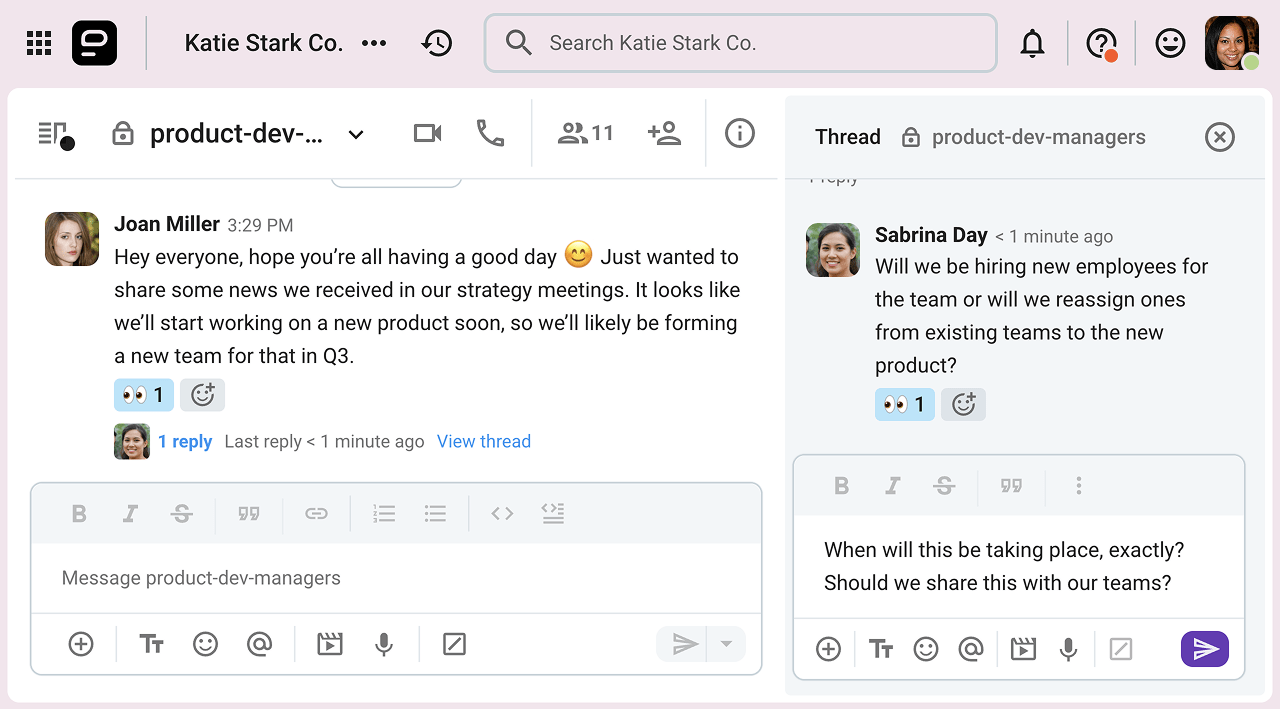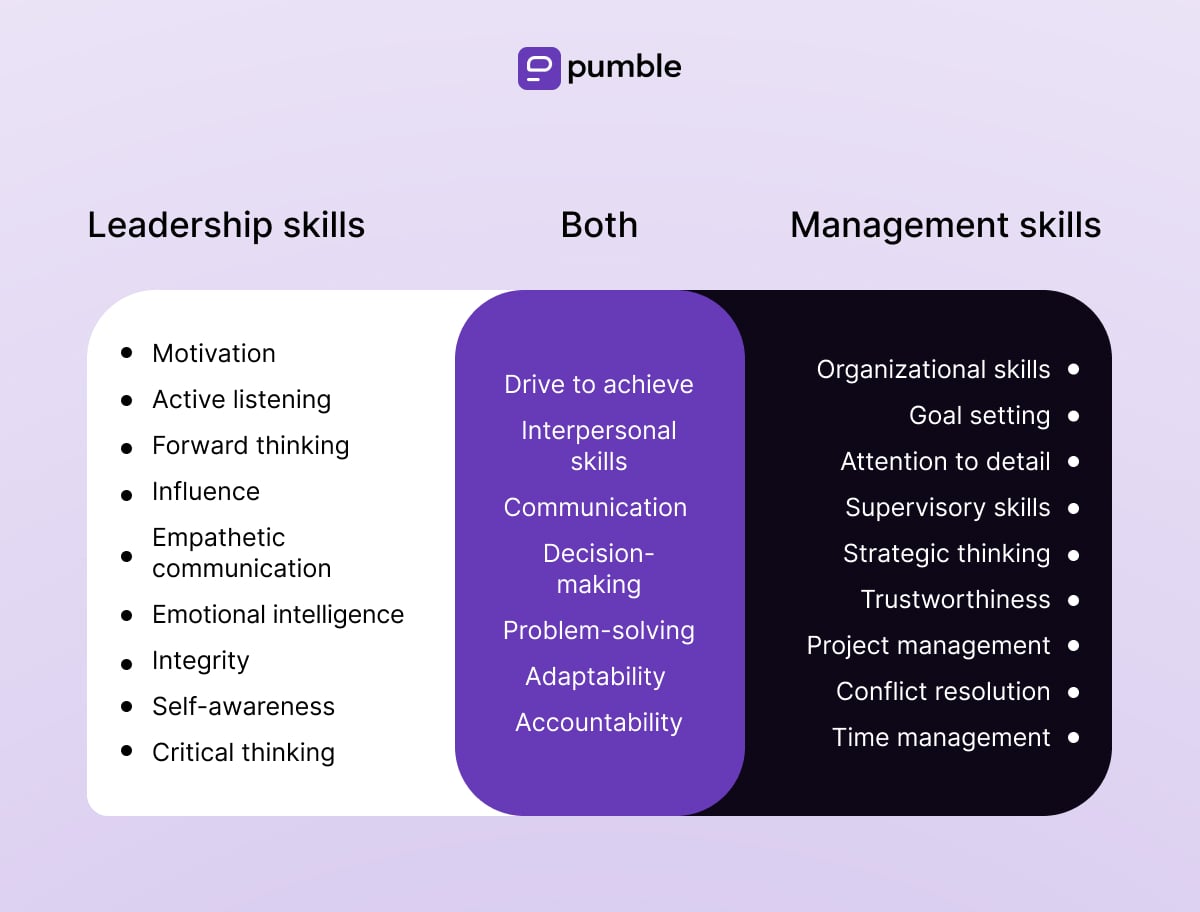If you’ve spent any time at all working in a collaborative business environment, you probably know that good leaders don’t necessarily make good managers — and vice versa.
Although these terms are often used interchangeably, leadership and management are two distinct categories, despite having some overlapping skills, characteristics, and functions.
But, when does a manager become a leader? And what is the difference between leadership and management?
To answer these questions, let’s start by analyzing 11 key differences between management and leadership.

Table of Contents
What is the difference between leadership and management?
The main difference between leadership and management is in the primary area of focus of managers and leaders. While managers prioritize organizing and maintaining a well-functioning system, leaders focus on inspiring, motivating, and spearheading change.
Where leaders inspire, managers direct, and where leaders drive change, managers maintain stability.
Although a person can be both a good leader and a good manager, we can easily distinguish a manager from a leader based on their approach to:
- People,
- Tasks, and
- Goals.
These 3 categories produce 11 key differences between management and leadership, which we are about to delve into. These dichotomies include:
- People vs tasks: Leaders focus on people, while managers focus on tasks or things.
- Vision vs execution: Leaders create an idea, and managers execute it.
- Thinking outside the box vs maintaining a system: Leaders tend to be more open-minded with their ideas, while managers work to maintain a system.
- Aligning vs coordinating people: Leaders align people with the company’s values and vision, while managers coordinate and organize them to complete more tangible goals.
- Shaping workplace culture vs shaping the day-to-day: Leaders shape the workplace culture, while managers shape the day-to-day.
- Future vs present: Leaders look into the future, while managers focus on the present.
- Driving vs implementing change: Leaders drive change, while managers implement it.
- Asking What and Why vs How and When: Leaders ask What and Why, while managers ask How and When.
- Strategies vs plans: Leaders make strategies, while managers make plans.
- Influence vs authority: Leaders have influence, while managers exercise authority.
- Quality vs position: Leadership is a quality, management is a position.
For more clarity, let’s examine how these categories can help us differentiate between leadership and management with examples of how they might play out in real-life situations.
Difference #1: People vs tasks
Although both leaders and managers try to build trust in their teams, leaders tend to be more people-focused than managers who, in turn, tend to focus more on the organizational aspect of team communication.
According to the author of The Leadership Decision and Lecturer at UMass Lowell, Catherine Rymsha, Ed.D., the difference between a leader and a manager is that one is more focused on business results while the other places more emphasis on forming interpersonal connections:

“Both leaders and managers have a commitment to their businesses, but managers focus strictly on business results and processes, whereas leaders find more of a balance with more focus on support and connection.”
A similar connection was noted by leadership and management consulting expert, Rhonda Y. Williams:

“Managers typically focus on tasks, seeking to control and optimize how objectives are met. Leaders, on the other hand, prioritize empowering and inspiring their team members. They understand their long-term success lies in developing people to reach their full potential.
In a corporate office, a manager might strictly enforce deadlines and monitor productivity closely. In contrast, a leader in the same environment would invest time in understanding each employee’s career aspirations and helping them develop the skills to achieve their goals.”
Though both leaders and managers can benefit from knowing their team members’ strengths and weaknesses, only true leaders would be invested in their team members’ professional development as well.
The example below illustrates this point through an exchange in Pumble, a team communication app, showing how a manager vs a leader may approach the matter of reassigning the workload of a sick employee. Milo, a manager, focuses on reassigning tasks while Nick, a leader, considers the professional development of his team members as well.

Get in touch with your team members on Pumble
Difference #2: Vision vs execution
No matter which leadership style a leader subscribes to, their primary responsibility is to develop a vision for a company and use their communication skills to convey that vision in an inspiring, motivating, and effective way.
Managers, on the other hand, are an integral part of making that vision a reality. They are the ones who will ensure that all the pieces come together to execute the leader’s vision.
As C. Nicole Mason, Author and Racial & Gender Equity Advocate, put it, leaders are chief communicators, while managers are main executors:

“Leaders create and hold the vision and strategy and set big milestone goals for the company. They are also the chief communicator — communicating the vision and strategy to internal and external stakeholders. Leaders have a macro view of all the moving pieces and work to ensure all the parts are working together and moving toward the same goals.
Managers execute the vision and strategy and translate both into action. Managers create plans and build effective teams to reach identified goals.”
So, a strategic leader, for example, will:
- Develop an inspiring vision,
- Create a goal-oriented plan to achieve it, and
- Motivate others to go after those goals.
They will boost employee morale and ensure all the people are on the same page.
However, managers have the organizational skills to make that vision a reality.

Communicate your ideas — hop on a video call on Pumble
Difference #3: Thinking outside the box vs maintaining a system
Ultimately, leadership tends to focus on developing their ideas even if that means changing the organization, whereas managers are more invested in maintaining the established system.
Visionary leaders often encourage others to get on their level by:
- Thinking outside the box,
- Engaging with their work, and
- Coming up with creative solutions through collaboration with their team members.
In other words, they inspire people to challenge themselves and the system.
Conversely, managers tend to thrive within the system. They’re the ones who will ensure all employees are performing as they should by setting SMART goals, for example, or conducting thorough performance reviews.
According to leadership expert Rhonda Y. Williams, that is the major difference between management and leadership:

“Management focuses on maintaining systems, processes, and structures to achieve efficiency. It’s about:
- Organizing,
- Planning, and
- Directing resources effectively.
Leadership, on the other hand, is the skillful execution of vision, inspiration, and change. Leaders aim to:
- Influence,
- Create motivating environments, and
- Empower others to leverage their talents to contribute to the organization’s success.”
However, these different approaches to work may cause clashes between leadership and management, as seen in the example below.

Difference #4: Aligning vs coordinating people
Knowing how to get people to do what you need them to do is a leadership skill both leaders and managers can benefit from developing. However, the way they use this skill may differ.
On the one hand, leaders tend to use their influence over people to make sure everyone is on board with the company’s goals and vision.
For example, transformational leaders influence the way people behave by fostering independence and improving performance in the workplace, while servant leaders create a positive work environment thus influencing people’s relationship to their job and company.
Either way, effective leadership can influence people’s:
- Behavior,
- Thoughts, and
- Engagement.
This last point is vital for a company’s success because low employee engagement costs companies around the world $89 trillion every year, according to Pumble’s overview of employee engagement statistics for 2025. In this regard, we might say that a leader’s positive influence on employees also protects the company’s bottom line.
On the other hand, managers without leadership potential tend to use their influence in a more straightforward way, as a means of coordinating and organizing employees. They focus on organizational details like allocating resources, coordinating teams, and measuring collaborative efforts to ensure everyone is pulling in the same direction.

Keep everyone in the loop with the company vision on Pumble
Difference #5: Shaping workplace culture vs shaping the day-to-day
Since managers are in charge of maintaining protocols, measuring and improving effectiveness, and administering decisions, they tend to be more focused on the day-to-day operations of a business.
On the other hand, leaders tend to be more concerned with the company culture. They infuse beliefs and values into the corporate system to:
- Foster a positive, inclusive culture,
- Determine how the organization should function, and
- Direct how the company goals will be achieved.
In other words, leaders set the tone. They are role models who showcase what behaviors and which mindsets are welcomed in the company and which aren’t.
This is of vital importance, as one recent survey of over 2,000 professionals revealed that 53.7% of respondents have previously quit their jobs due to toxic work culture.
The same survey showed that 58.9% of respondents would make the switch to a lower-paying job if their new employer offered a better work environment, underscoring the impact culture has on employee retention.
Of course, once a leader has set the tone, it’s up to the managers to uphold that tone on a day-to-day basis. So, leaders establish a culture, while managers endorse and support it.
💡 PUMBLE PRO TIP
Cultural intelligence is a massive contributor to successfully setting the tone in the workplace. To find out what that is and how to improve it, read the blog post below:
Difference #6: Future vs present
One of the biggest differences between leadership and management is the focus of their plans.
While management takes care of everything that needs to be done today or by the end of the week or month, leadership must consider everything that comes after the most immediate plans are executed.
After all, that kind of future-oriented thinking is one of the staples of leadership communication, as Mason noted:

“Leaders are concerned with the big picture, motivating key stakeholders to achieve high impact and driving the overall outcomes and success of a company or organization. They make tough and big decisions and take responsibility when things go wrong or not as expected.”
Although looking into the future is a necessity for the success of any company, focusing on the present — something that managers can do — is equally important.
As Albert Orbinati, Ph.D., Associate Professor of Business Administration and Chair of Business at Champlain College, noted, a manager’s ability to steer the team in the direction of the future the leader is looking into is a notable skill:

“Managers are traditionally like the crew of a ship, ensuring that the day-to-day operations run smoothly. They tend to focus on the now — organizing resources, creating plans, and following through with implementing strategies to achieve specific goals set by leadership. Their role is critical in translating the vision into actionable steps and measurable outcomes.”
Embrace the future of team communication with Pumble
Difference #7: Driving vs implementing change
Leaders are notorious risk takers. They seek, motivate, and drive change in their organizations, while empowering employees to take risks as well. As Orbinati put it, this kind of drive is a necessary part of leadership:

“Leaders are the agents of change. They challenge the status quo, propose new ideas, and are comfortable taking risks to drive transformation. Leaders are expected to be adaptable, flexible, and forward-thinking.”
Strategic risk-taking is a vital component of visionary leadership and other leadership styles. A good leader will always try to find ways the organization can change for the better — which is why they will encourage others to seek innovative solutions, new approaches, and novel ideas.
Managers, on the other hand, prefer stability to change. At the same time, they play a vital role in implementing the changes proposed by leadership.
Changing an organization’s processes, goals, objectives, or vision affects a lot of things. A change that big needs to be followed by adjustments in the system — scheduling, task organization, allocating resources, staffing, etc.
As Orbinati testifies, this is well within the scope of managers’ capabilities:

“Managers, traditionally, maintain and optimize existing systems and processes. They focus on short-term tasks and specific goals. Managers implement and enforce policies and procedures and often prioritize efficiency, control, and problem-solving within existing frameworks.”
💡 PUMBLE PRO TIP
Change is a necessity in every organization, but that doesn’t mean it’s always welcome. If your organization is struggling with implementing and communicating change to your employees, then get the best tips from the blog post below:
Difference #8: Asking What and Why vs How and When
The difference between leadership and management runs so deep that even the questions that leaders ask themselves are different from the ones managers contemplate.
While questioning everything and challenging the status quo, leaders tend to consider questions like What and Why. In other words, future-oriented leaders tend to ask themselves What needs to change and Why.
Conversely, managers ask questions like How and When — focusing on How suggested changes should be implemented and within what time frame, as highlighted by the exchange below.

Stay on top of new developments on Pumble
This is something our contributor Williams highlights as a particularly important difference between leadership and management:

“Leaders concern themselves with the what and why, often leaving the how to their teams. This ‘how’ is incredibly empowering and allows the team to stretch and grow. Leaders focus on innovation, strategic planning, and inspiring their team towards a shared vision. Managers tend to focus on the operational side of an organization. They are concerned with how things get done, emphasizing control, administration, and implementing established processes.”
Williams offered a real-life example of what this distinction might look like.

“In a tech company, a leader might focus on envisioning the next groundbreaking product, inspiring the team with a compelling vision. A manager in the same company would then take this vision and work on the logistical aspects, such as assigning tasks, setting timelines, setting the budget, and ensuring the project stays on budget.”
Difference #9: Strategies vs plans
Strategizing and strategic thinking are skills that both managers and leaders should excel at.
But, as we have established, visionary leaders tend to be more capable of looking into the future than managers who don’t have those leadership skills.
Because of that, leaders’ strategies are often more extensive, while plans made by managers have more immediate effects — though they are still a part of the overall strategy established by leadership.
As the Lead Talent Attraction Partner at Southern New Hampshire University, Mary Bertolino, SHRM-SCP, PRC, put it, there’s a massive difference between the types of plans leaders and managers make:

“Leaders are strategic long-term thinkers and think about how their actions now will impact their team in the long run. Managers are more concerned with short-term operational goals and metrics.”
The table below shows the difference between leadership and management in terms of the primary objectives of their respective strategies and plans.
| LEADERS STRATEGIZE ABOUT: | MANAGERS PLAN ABOUT: |
|---|---|
| Company objectives | Organizing tasks |
| Core values | Directing people |
| Strengths and weaknesses | Allocating resources |
| Opportunities | Coordinating teamwork |
| Threats | Managing budgets |
Communicate your plans via Pumble
Difference #10: Influence vs authority
So far, we’ve uncovered many ways in which leadership and management may differ in their approach to work. However, the most notable one, at least for people working under them, is how they lead.
Namely, leaders lead through influence, though the way they establish that influence may differ.
For example, a laissez-faire leader would build trust by allowing employees to operate completely independently, while still providing all the resources they need to thrive.
So, even though those who practice this leadership style aren’t too involved with their team members’ daily activities, they still wield considerable influence, as their minimal interventions allow employees to be more creative within the scope of their tasks.
Of course, building trust is only one way a good leader might increase their influence. They can also:
- Lead with empathy and show genuine concern about other people’s well-being, goals, and aspirations,
- Use emotional intelligence and charisma (and quite a few persuasive techniques) to get what they need, and
- Use respectful communication with their employees.
On the other hand, managers who don’t have a solid understanding of these leadership skills tend to lead by exercising authority.
In practice, that means they might be more prone to using formal communication when communicating with subordinates as a means of maintaining organizational hierarchy.
💡 PUMBLE PRO TIP
Ultimately, management serves as the bridge between employees and leadership. Because of that, they often engage in upward and diagonal communication with upper leadership, as well as lateral communication with other managers. To learn more about these types of professional communication, check out the following blogs:
Difference #11: Quality vs position
Last but not least, perhaps the most important difference between leadership and management is that one of these things is a quality that anyone in the company can possess, while the other is a position within the organization.
In other words, leadership is a quality, a set of skills anyone can have. If you have a knack for leadership, you will be perceived as a leader. People might even naturally flock to you or look to you for solutions, even if you don’t have a leadership position.
That is exactly what emergent leadership is — a style of organizational management that allows leaders to emerge organically within the organization. That means that proactive employees who take it upon themselves to step into leadership roles within the company can be rewarded with positions that match their natural abilities.
These positions will typically be in management — proving that leadership and management can and often do coexist in one person.
So, ultimately, it’s not a matter of leader vs manager. As we have discovered, these two categories may be more similar than we previously thought.
With that in mind, let’s take a moment to discuss some of those commonalities that can occur in both leadership and management.
How are leadership and management similar?
Having discussed all the differences between leadership and management, it’s time to tackle the similarities between the two.
In the words of Stephen Covey, author of the The 7 Habits of Highly Effective People:
“Management is about climbing the ladder; leadership determines whether the ladder is leaning against the right wall.”
— Stephen Covey
So, even from the metaphor above, it’s clear that management and leadership have some things in common.
And, indeed, both leadership and management require a specific skill set. For more information, let’s take a look at the most important leadership and management skills.
| LEADERSHIP SKILLS | MANAGEMENT SKILLS |
|---|---|
| Motivation | Organizational skills |
| Active listening | Goal setting |
| Forward thinking | Attention to detail |
| Influence | Supervisory skills |
| Empathetic communication | Strategic thinking |
| Emotional intelligence | Trustworthiness |
| Integrity | Project management |
| Self-awareness | Conflict resolution |
| Critical thinking | Time management |
But where does the Venn diagram of skills overlap when it comes to management and leadership?
As you can see in the image below, skills and qualities that both leaders and managers have are:
- Drive to achieve,
- Interpersonal skills,
- Communication skills,
- Decision-making skills,
- Problem-solving skills,
- Adaptability, and
- Accountability.

Practice your communication skills on Pumble
Similarity #1: Drive to achieve
Although they may approach the issue from different perspectives, both leaders and managers have the same burning drive to succeed, according to C. Nicole Mason:

“The most notable similarity between leadership and management is the drive to achieve excellent outcomes and goals. They both want the same thing for the company or organization — to be effective, deliver on the mission, and have a high impact. Leaders need managers, and managers need good leaders to succeed.”
Even so, leaders and managers may view success differently — since leaders set long-term and managers short-term goals.
For example, most managers have enough personal ambition to have gotten promoted to management — they may have even asked for that promotion. So, at the very least, they are driven to achieve success in order to advance professionally.
On the other hand, a true leader might prioritize the success of their vision over any personal goals. However, both managers and leaders would welcome and celebrate their organization’s successes just as enthusiastically.
Similarity #2: Interpersonal skills
Interpersonal skills are vital both for leaders and managers, as they can facilitate the realization of both long and short-term goals.
Strong interpersonal communication skills can help leaders and managers:
- Motivate employees,
- Foster engagement,
- Encourage collaboration, and
- Achieve goals.
If you want to work on your workplace relationships, you can start by making the most of the tools you have. For example, you can use Pumble, the employee communication app, to participate in casual conversations in designated channels, as shown in the image below.

Start a casual conversation with your coworkers on Pumble
Similarity #3: Communication skills
Communication skills are also quite high on the list of important skills for those in leadership roles because effective communication can make or break a company.
In the words of our contributor Bertolino, there are no successful leaders or managers with poor communication skills (or at least there shouldn’t be), because that’s what they value and seek out:

“Both leaders and managers are high communicators and value effective communication.”
The reason for this is that poor communication is a common cause of workplace failure — something 86% of employees agree on.
What’s more, the top benefits of effective communication are also among the top goals all managers and leaders want to achieve:
- Improved productivity,
- Improved engagement, and
- Higher employee retention.
💡 PUMBLE PRO TIP
Effective communication is a must in every organization. If you think you need to brush up on your communication skills, get the best tips and tricks on how to do that from the guide below:
Similarity #4: Decision-making skills
The burden of making decisions falls both on managers and leaders, which is why all of them need strong decision-making skills.
Our contributor, Bertolino, highlighted this quality as one similarity between managers and leaders that still slightly sets them apart from one another:

“Both leaders and managers are not afraid to make decisions. The difference is that leaders tend to make more strategic decisions, while managers will focus more on operational decisions.”
Orbinati agrees and adds that decision making is perhaps the most important skill for all managers and leaders:

“Decision making is central to both roles, with each making choices that can significantly impact their teams and the larger organization. Leaders often decide on strategic direction and policy, while managers make more immediate operational decisions. Despite these differences in scope, both are responsible for the outcomes of their decisions and must weigh risks and benefits carefully.”
💡 PUMBLE PRO TIP
Decision making is a difficult skill to acquire, especially in a remote team. To learn more about how you should make decisions in remote teams, check out the blog post below:
Make the right decision — choose Pumble
Similarity #5: Problem-solving skills
Another vital skill for managers and leaders is problem solving.
After all, both leadership and management roles come with complex challenges that require brainstorming and problem-solving skills.
Having robust problem-solving skills help leaders and managers:
- Navigate challenges,
- Anticipate and adapt to change,
- Improve their own and overall efficiency,
- Boost collaboration, and
- Manage risk.
💡 PUMBLE PRO TIP
If you’re looking for a new problem-solving technique to put to the test, why not try brainwriting? Not sure what that is? We’ve got you covered:
Similarity #6: Adaptability
Now, we’ve mentioned that leaders tend to be more open to change than managers who aren’t interested in stepping into leadership roles. However, in reality, both leaders and managers need to be adaptable to succeed.
Leaders are traditionally more resilient and bigger advocates of change, but that doesn’t mean that managers don’t need to be adaptable.
Even though managers are usually more invested in maintaining the status quo, they are ultimately the people who are tasked with implementing the changes suggested by leadership.
Therefore, managers also need to have an open mind and an adaptable approach to be able to shift priorities, change work processes to increase efficiency, or be responsive to new information, for example.

Expect the unexpected — talk on the go with Pumble
Similarity #7: Accountability
Finally, the last skill managers and leaders have in common is probably the toughest to bear — accountability.
People who hold leadership roles need to be able to take responsibility for the decisions they make as well as the actions of the people under their supervision.
As Orbinati states, both leaders and managers share this burden:

“Leaders and managers are both answerable for the welfare and performance of their teams. This involves not just achieving targets but also attending to the development, morale, and well-being of their team members. They bear the burden of the consequences of the team’s actions and the responsibility for guiding them to success.”
The flip side of this coin is that leaders and managers also get to reap the benefits of accountability and take the glory of success (as long as they first carry the burden of responsibility, of course).
💡 PUMBLE PRO TIP
Wondering how you can become more accountable even if you work from home? This guide will help you develop that skill:
Be the best manager or leader you can be — with Pumble
Ultimately, though leadership and management are fundamentally different concepts, they can still coexist in some people, according to Rhonda Y. Williams:

“Recognizing the leadership role of managers helps in appreciating the comprehensive and multifaceted nature of running successful organizations, where different styles of leadership coexist and complement each other to achieve a common purpose.”
Both managers and leaders play vital roles in an organization’s success because they are responsible for the constant flow of communication that ultimately paves the way for top performance.
To ensure that you’re playing your part as a manager or a leader, see to it that all the members of your team — operational, managerial, and those in leadership positions — are interconnected by providing them with the tools they need to keep the channels of communication open.
Pumble, a business messaging app, can help you realize your full potential as a leader or a manager by centralizing communication and making collaboration easier. You can use it to:
- Encourage and motivate team members through direct messages,
- Brainstorm your next moves in channels and threads,
- Get your point across with voice and video messages, and
- Build your influence with voice and video calls.
So, take advantage of the powerful software that will save your team time and increase their productivity.








